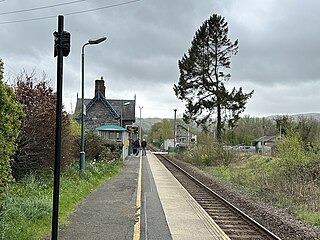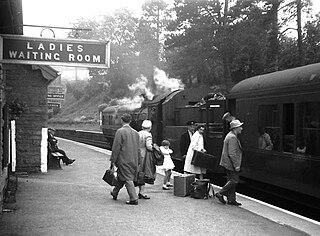
The Cambrian Railways owned 230 miles (370 km) of track over a large area of mid Wales. The system was an amalgamation of a number of railways that were incorporated in 1864, 1865 and 1904. The Cambrian connected with two larger railways with connections to the northwest of England via the London and North Western Railway, and the Great Western Railway for connections between London and Wales. The Cambrian Railways amalgamated with the Great Western Railway on 1 January 1922 as a result of the Railways Act 1921. The name is continued today in the route known as the Cambrian Line.

The Cambrian Line, sometimes split into the Cambrian Main Line and Cambrian Coast Line for its branches, is a railway line that runs from Shrewsbury, England, westwards to Aberystwyth and Pwllheli in Wales. Passenger train services are operated by Transport for Wales Rail between the western terminals of Pwllheli, in Gwynedd, and Aberystwyth, in Ceredigion, and the eastern terminal at Shrewsbury, Shropshire, as part of the Wales & Borders franchise. The railway line is widely regarded as scenic, as it passes through the Cambrian Mountains in central Wales, and along the coast of Cardigan Bay in Snowdonia National Park.
The Central Wales Football League(formerly the Mid Wales Football League) is a football league in Wales at tier four of the Welsh Football pyramid, run by the Central Wales Football Association. The league consists of two regionally based divisions - a Northern Division and a Southern Division. The league offers a promotion route to the Football Association of Wales administered tier three Ardal Leagues. Relegation is possible to the relevant tier five level leagues in Aberystwyth, Ceredigion and Montgomeryshire.

Newtown railway station is a railway station serving Newtown, Powys, Wales.

Caersws railway station is on the Cambrian Line in mid-Wales, serving the village of Caersws. It is notable in that there are 22 miles (35 km) separating this station and Machynlleth, the longest distance between two intermediate stations in Wales.

Machynlleth railway station is on the Cambrian Line in mid-Wales, serving the town of Machynlleth. It was built by the Newtown and Machynlleth Railway (N&MR) and subsequently passed into the ownership of the Cambrian Railways, the Great Western Railway, Western Region of British Railways and London Midland Region of British Railways. It is notable in that there are 22 miles (35 km) separating this station and Caersws, the longest distance between two intermediate stations in Wales.
The Aberystwith and Welsh Coast Railway was a standard gauge railway company, running a line along the west coast of Wales.

Llanidloes railway station is a former junction railway station in Llanidloes, Powys, Wales. The Cambrian Railways, which completed the building in 1864, designed it to be both the station for the town and its company headquarters. This dual purpose gave Llanidloes station an imposing appearance.

Strata Florida was a railway station in Wales, on the former Carmarthen to Aberystwyth Line; it served the villages of Ystrad Meurig, Pontrhydfendigaid and Ffair Rhos. The Manchester and Milford Railway (M&MR) opened from Pencader to Aberystwyth on 12 August 1867; the line went into receivership from 1875 to 1900. The site is now part of the Ystwyth Trail, a shared-use rail trail between Aberystwyth and Tregaron.
Llanfaredd Halt railway station was an unstaffed railway station opened by the Great Western Railway on 7 May 1934 on the old Mid-Wales line between Builth Wells railway station and Aberedw railway station in Powys, Wales.
The Llanidloes and Newtown Railway (L&NR) was a railway company between Llanidloes and Newtown in Montgomeryshire, Wales. It was promoted locally when plans for trunk railways passing through the locality were cancelled; local people saw that a railway connection was essential to the flannel industry in the district. The 17-mile (27 km) line opened in 1859, and at first was isolated from any other railway, but from 1861 it became connected to Oswestry by an allied railway company, and other companies also connected to it. From 1864 the company was incorporated into the new Cambrian Railways company.

The Mid-Wales Railway was conceived as a trunk route through Wales connecting industrial areas in North West England with sea ports in South West Wales. The company was prevented from reaching its goal by competing proposals in Parliament, and it was only able to build a line between Llanidloes and a junction with the Brecon and Merthyr Railway 5 miles (8 km) east of Brecon. The line was 70 miles (110 km) long and opened in 1864. The company found it impossible to raise the share subscription, but the contractor partnership of Davies and Savin agreed to build the line and take shares in payment,

Carno is a closed railway station in Carno, on the Cambrian Line, that was part of the Newtown and Machynlleth Railway. The station was closed in 1965 as part of the Beeching Cuts though there are proposals to re-open it.

Talyllyn Junction was a railway junction located 4 mi (6.4 km) east of Brecon, Powys, opened in 1869. The junction was triangular, with north, east and west chords, station platforms being sited at the western junction and also, until 1878, at the eastern junction. The Junction took its name from the adjacent tiny hamlet.
The Oswestry and Newtown Railway was a British railway company that built a line between Oswestry in Shropshire and Newtown Montgomeryshire, now Powys. The line opened in stages in 1860 and 1861. It was conceived to open up the area to rail transport, when local opinion formed the view that the trunk railway companies would not do so. Subscription money for the construction proved very difficult to generate. It was the action of a contractor partnership, Davies and Savin, in agreeing to accept shares as the majority of their payment for construction work, that saved the company from failure.
The Oswestry, Ellesmere and Whitchurch Railway was a railway company that constructed a line from Whitchurch via Ellesmere to Oswestry. Most of the line was in Shropshire but part entered Flintshire, now Wrexham County Borough. It was seen as a link from the local railways around Newtown to the London and North Western Railway, breaking the local monopoly of the Great Western Railway. It opened as a single line in 1863 and 1864. Throughout the construction period it was short of money, and was paid for by the contractor, who took shares. Sporadically through its life it became a useful part of a through route for mineral trains, but it never developed greatly.

The Newtown and Machynlleth Railway was a railway company in Wales. It built a line from a junction with the Llanidloes and Newtown Railway near Caersws to the market town of Machynlleth; the line opened in 1862. Newtown had become the hub of railway lines in the district. Machynlleth was an important town, and extension from there to Aberystwyth and to the coast northward was in the minds of the promoters.

Llangurig railway station was intended to serve the village and rural locale of Llangurig in the Welsh county of Powys. The station, which was on the Llangurig branch, was built and operated by the Manchester and Milford Railway (M&MR). It was to be located in a shallow rock cutting just above the village.

Llandinam railway station was a station serving Llandinam, Powys, on the Llanidloes and Newtown Railway (L&NR) line. The L&NR was authorised in August 1853; construction began in October 1855 and the line was opened between those points for goods traffic only on 30 April 1859 – passengers were carried from 31 August 1859. Llandinam was one of three intermediate stations on the 13-mile line. The station was opened in 1859 by David Davies who was born in Llandinam and was a major contractor for building the line. In July 1864 the L&NR amalgamated with three other railways to create the Cambrian Railways, which in January 1922 amalgamated with the Great Western Railway which itself became part of British Railways in 1948.

Boughrood and Llyswen railway station, in Boughrood Powys, Wales, was opened on 21 September 1864 by the Mid-Wales Railway as Boughrood Station, although excursions ran on 19 September and 20 September. It became Boughrood and Llyswen station on 1 October 1912 while under the ownership of the Cambrian Railways. On a single track main line, it had a passing loop with platforms on either side and a signal box at the northern end of the platform to Moat Lane Junction. The station closed on 31 December 1962.














